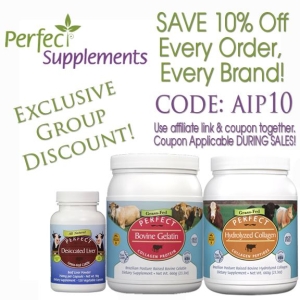Looking for ways to bring some spice to your AIP plate? I’ve got you!
First, let’s start with a bit of reassurance … strict, elimination stage AIP is not meant to last forever, and many spicy options are among the list of early reintroductions.
In the meantime, I’m including some resources on what to include, what to avoid, and how to spice things up and elevate your dishes … because AIP need-not be boring or flavorless!
What’s In, What’s Out?
Dr. Ballantyne also had a post on her website that I’d recommend – Spices on the Autoimmune Protocol – it’s a list of what’s in and what’s out from Dr. Ballantyne. If you want to understand the “whys” behind the eliminations, click the link above for The Autoimmune Protocol book to learn more.
For a comprehensive list of AIP foods and, including the order of reintroduction, my #1 recommendation is Dr. Sarah Ballantyne’s The Autoimmune Protocol book – grab your copy here.
The Basics:
Don’t Skimp: First and foremost, don’t skimp! In my years of AIP cooking, I find a lot of the recipes are a little light-handed on seasoning. Review the ingredient lists and quantities before you start cooking, and be sure to taste as you go. Try using more herbs than you’re accustomed to. Not only do they add lots of flavor, most have plenty of healing benefits.
Find Your Balance: While I’m no expert, I do know that finding balance in cooking and sauces is so important for bringing out the best in your meal. Sometimes a simple squeeze or zest of a lemon, or a dash of a compliant vinegar is all you need to add brightness to a dish. Salt brings out flavors, and an extra pinch might just be the ticket. On the AIP, we’re avoiding refined sugar, so sweetness might be lacking in AIP recipes. Check your flavors as you cook and decide if a pinch or drizzle of a compliant sweetener might enhance the taste, or experiment with a vinegar you’ve never tried before. While apple cider vinegar is the most common AIP vinegar option, a quality balsamic can add a sweet and savory twist. Have you tried champagne, ume plum or sherry vinegar? Need more umami (savory depth of flavor)? What about mushrooms, sea vegetables, fish sauce or anchovy paste? Try to look at your AIP journey as a blessing to push you outside your comfort zone in the kitchen .. I know I’ve become a better cook thanks to the challenge of needing to find compliant alternatives. Want to learn more about balancing flavors? This article on flavor balancing and how to fix a recipe may be helpful – click here (note, it’s not specifically AIP, so watch which ingredients you choose to use).
Spice It Up: If you’re missing heat in your dishes, get creative with ingredients like fresh ginger (or very fresh ginger powder), garlic, radishes, fresh grated horseradish (prepared horseradish typically contains non-compliant ingredients, but you can make your own – click here), and wasabi powder!
This post – How to Find Flavor in AIP Spices – provides some creative ways to make your dishes more flavorful.
Onions & Garlic Not Your Friend? If you’re sensitive to onions and garlic, that can make things a little trickier, but it’s not impossible! Have you experimented with green onions (or scallions) – they are great FODMAP-friendly onions. Just be sure you only use the green part! Chives are also a wonderful choice for oniony flavor. Leek greens are low FODMAP as long as you keep your serving to ⅔ cup or less. If that doesn’t work for you, try making your own garlic, onion or chive infused oils and salts – these are often better tolerated. My partner shop, Casa de Sante has a few pre-made seasoning, oils and dressing options for you – click here.
Pre-Made Options:
Looking for quality spices and pre-made blends, sauces and oils? Check out my categorized AIP Storefronts on Amazon – try the seasonings and salts categories, baking ingredients and hard to find items for inspiration. There’s even a search function there above my posts – so just type the item you’re after and then click in the category and you’ll find it. Click the following link for the shop closest to you (there are several categories there that you’ll find ingredients to help zhuzh up your dishes) – USA / Canada / UK.
AIP Cookbooks:
Looking for inspiration in the convenience of a cookbook? You can find recommendations in my AIP Storefronts on Amazon in my “AIP Books, Cookbooks & Good Reads” section. There are dedicated options featuring Italian, Indian, French and Latin American AIP cuisine. Click the location nearest to you and browse around! – USA / Canada / UK.
If you want a variety of “spicy” AIP recipes to help you be more adventurous with using herbs and spices in the kitchen on AIP, you’ll want to grab “Spice” by Jo Romero. In addition to recipes for drinks, desserts, main meals, side dishes and snacks you’ll find information on individual herbs and spices and learn how to make an AIP-compliant curry of your own. There are also AIP versions of takeaway favourites such as Chinese Style Lemon Chicken, Lamb Dopiaza and Chip Shop Style Curry Sauce as well as AIP-compliant Naan Breads. Click the location nearest you USA / Canada / UK.
DIY Blends:
To make your life easy, I’m including a number of basic DIY AIP spice blends to get you started. Having them prepped in advance can take the stress out of busy weeknights and breakfasts.
Simply blend spices and store in a glass jar in your pantry. For those that you’ll use more regularly, consider doubling the recipe.
Soy Sauce Substitutes
Try Coconut Aminos or Fish Sauce – Find them in my AIP Amazon Storefronts – USA / Canada / UK
Need a Coconut-Free Soy Sauce Option? I have three for you! (Watch the labels on your ingredients. Red Boat is the best Fish Sauce for AIP)
Soy Sauce Substitute 1
Soy Sauce Substitute 2
Soy Sauce Substitute 3 (use nomato sauce unless you’ve reintroduced tomatoes)
Worcestershire Sauce
Click here and here for two recipe options
All-Purpose Seasoning 1
2 tablespoons Himalayan sea salt
4 teaspoons dried oregano
4 teaspoons onion powder
4 teaspoons powdered ginger
3 teaspoons powdered turmeric
2 tablespoons onion powder
2 tablespoons garlic powder
1 tablespoon powdered ginger
1 tablespoons Himalayan sea salt
2 tablespoons dried parsley
All-Purpose Seasoning 3
Click here for the recipe on my website
Breakfast Seasoning
Click here for the recipe on my website
2 tablespoons dried basil
2 tablespoons dried oregano
1 tablespoon dried rosemary
2 tablespoons dried marjoram
2 tablespoons dried cilantro
2 tablespoons dried savory
1 tablespoon dried thyme
Greek Seasoning
2 tbsp oregano
1 tbsp dried basil
1 tbsp dried thyme
1 tbsp dried rosemary
1 tbsp dried dillweed
1 tbsp parsley flakes
1 tbsp onion powder
1 tbsp garlic powder
1 tbsp salt
1 tsp marjoram
1 tsp cinnamon
1/4 tsp mace
Ranch Seasoning
1 tablespoon Sea Salt
1 tablespoon Garlic Powder
1 tablespoon Onion Powder
2 tablespoons Dried Parsley
2 tablespoons Dried Basil
2 tablespoons Dried Chives
1/2 tsp Black Pepper (omit unless you’ve reintroduced)
BBQ Spice Rub
2 tablespoons smoked sea salt
¼ teaspoon ground cloves
1 teaspoon turmeric
2 tablespoon onion powder
4 tablespoon garlic powder
1 teaspoon dried oregano
1 teaspoon ginger powder
4 tablespoon coconut sugar (can be omitted for sugar free/Keto)
4 tablespoons toasted carob powder
2 tablespoons powdered turmeric
2 teaspoons dried oregano
2 teaspoons onion powder (my suggestion)
2 teaspoons garlic powder (my suggestion)
2 teaspoons cinnamon
2 teaspoons Himalayan sea salt
2 teaspoons powdered cloves
1 teaspoon powdered ginger
1 tablespoon garlic powder
1 tablespoon onion powder
1 tablespoon powdered turmeric
2 teaspoons dried cilantro (not coriander)
2 teaspoons dried basil
2 teaspoons dried dill
2 teaspoons cinnamon
1 teaspoon powdered ginger
1/2 teaspoon powdered cloves
Curry Powder 2
2 Tbsp powdered ginger
1 Tbsp powdered garlic
2 Tbsp powdered turmeric
2 tsp ground cinnamon
1/2 tsp ground cloves
2 Tbsp dried cilantro/ coriander leaves
1 tsp fenugreek leaves
1 tsp crushed curry leaves
Curry Powder 3
Click Here for my favorite blend – it’s so simple and delicious!
3 tablespoons dried thyme
2 tablespoons dried sage
2 tablespoons dried marjoram
1 tablespoon dried rosemary
1/2 teaspoon dried savory
Herbs de Provence
2 tablespoons dried rosemary
1 tablespoon fennel seed (if you’ve reintroduced – otherwise, omit)
2 tablespoons dried savory
2 tablespoons dried thyme
2 tablespoons dried basil
2 tablespoons dried marjoram
2 tablespoons dried lavender flowers
2 tablespoons dried Italian parsley
1 tablespoon dried oregano
1 tablespoon dried tarragon
1 teaspoon bay powder
Apple Pie Spice
5 tsp ground cinnamon
1/2 tsp ground mace (1 tsp nutmeg if you’ve reintroduced)
1/4 tsp ground cloves
(1/2 tsp ground cardamom if you’ve reintroduced)
Pumpkin Pie Spice
5 tsp ground cinnamon
2 tsp ground ginger
1/2 tsp ground cloves
1/4 tsp ground mace (or 1/2 tsp ground nutmeg if you’ve reintroduced or omit)
Looking for More?
What about ketchup, mayo, mustard and other condiments? There are plenty of recipe links posted in my searchable Facebook Group – click to join! You’ll find more herb and spice blends, rubs, infused salts, oils and so much more.
Once you get there, try searching “spice” “seasoning” or even #seasoningsaturday – from time to time I do a bit of a running theme, so I try to use hashtags to make future searches easy-peasy! Search also for terms like “condiment” “sauce” or “dip” or search for exactly what you’re looking for like “ketchup” “mustard” “mayo” “BBQ Sauce” and even “curry” – the inspiration is endless!
AIP Baking Powder
Why make your own? Because store-bought brands contain grain (corn starch) or potato starch, and even aluminum.
EXCITING NEWS! You can purchase AIP Compliant Baking Powder in my Amazon Storefronts –USA / Canada
TIP: I’ve read that you can use arrowroot starch OR tapioca starch/flour in these recipes. Some Baking Powder recipes don’t call for either, but it’s said to add texture to recipes using alternative flours so it’s not surprising to see it added here.
Baking Substitutions
Overall, substitutions in AIP baking are NOT recommended (I encourage you to read more about that here), so save yourself the time, money and attempted wizardry in the kitchen and simply follow an AIP recipe that’s already been tried and tested by some exceptional recipe creators. They spend a LOT of time to perfect their recipes before presenting them, so trust their experience and brand recommendations when it comes to flours because quality and texture differs between brands. Be sure to join the AIP Recipe Collection Facebook Group for lots of compliant recipes – click here.
AIP Swaps
Gelatin Eggs / Egg Replacements – Check out my post here for several variations
AIP Milk Options – check out my post on this – click here.
AIP Flour – While there are a number of AIP compliant flours that you can use (cassava, tigernut, coconut, tapioca, arrowroot, plantain, green banana), they can be tricky to work with. Cassava flour is the closest option for 1:1 all-purpose use, however it simply doesn’t not react the same as traditional flours and many complain that their AIP baked goods come out gummy. For the most part you’ll find better success when a recipe calls for more than one type of AIP flour. Be sure to join the AIP Recipe Collection Facebook Group for lots of tried and true compliant recipes – click here.

 If you’re concerned about a certain deficiency, I encourage you to do a quick Google search (search: “What foods are rich in X…”) to find out what foods are rich in that vitamin/nutrient, or better yet, check out my post –
If you’re concerned about a certain deficiency, I encourage you to do a quick Google search (search: “What foods are rich in X…”) to find out what foods are rich in that vitamin/nutrient, or better yet, check out my post – 
